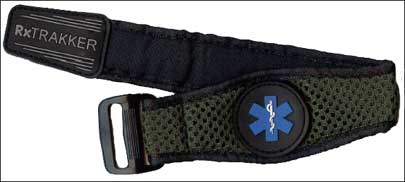Auto-identification and bar-code systems provider eSunTech Canada, headquartered in Windsor, Ontario, with offices in Bel Air, Md. and Detroit, has launched a new RFID-enabled system designed to provide emergency and health-care personnel with instant access to vital medical information. The system leverages 13.56 MHz high-frequency (HF) technology based on the ISO 15693 RFID standard, and includes software with compression capabilities, enabling customers to store a variety of information directly on each RFID transponder.
The RxTrakker system incorporates RFID transponders from Texas Instruments (TI) and mobile computers manufactured by Psion Teklogix. Each computer is equipped with a display (to view data), an alphanumeric keypad (for data entry), an RFID interrogator and a bar-code scanner. The computers use eSunTech-designed, Web-based software that interfaces with a back-end server via a wired or Wi-Fi-enabled local area network.
The application employs an encapsulated transponder designed for tracking garments in laundries and withstanding up to 200 wash cycles. A patient’s medical history can be encoded in the transponder, which can then be attached to wristbands, belts, watchbands or lanyards, or incorporated in other form factors. The RFID chip can store 2 kilobytes of data, encrypted to protect the patient’s privacy.
ESunTech has implemented a proprietary encryption algorithm that prevents anyone from reading or rewriting the transponder’s data without the appropriate combination of software and hardware. A typical medical history might include a patient’s contact information, next of kin, doctor’s contact information, blood type, medical conditions, allergies and medical insurance information.
Although the transponder has a storage capacity of only 2 kilobytes, the compression technology built into eSunTech’s software enables the device to carry quite a bit of data, explains John Avalos, eSunTech’s VP of sales and business development. “Other solution providers have encoded only a unique ID number on the transponder, and when the tag is read, they have to reference a database elsewhere,” Avalos says. “Rather than take that approach, we’ve designed the software so we can encode a mini-database with medical information right onto the RFID transponder. That way, the information can be accessed immediately.”
The amount of information that can be encoded on the transponder depends on the type of data being used. For example, the company’s compression technology enables customers to encode twice as much numeric data on the transponder as would be possible otherwise. “But it is hard to give an exact percentage of how much you can encode,” Avalos says. “For alpha data, we use one compression format; for numeric data, we use another. Often, there is both alpha and numeric data, so the amount that can be encoded using the compression depends.”
ESunTech is targeting RxTrakker to emergency response agencies, as well as to health-care organizations such as assisted living centers. “The transponders are ideal for disabled people,” Avalos explains, “such as speech-impaired of hearing-impaired—really, any person that wishes to ensure their medical information is with them at all times.”
In addition, the company currently offers another RFID-enabled product, known as XcelTracker. This asset-management solution leverages ultrahigh-frequency (UHF) EPC Gen 2 technology, but can also be customized to work with active real-time location and bar-code technologies. For RxTrakker, eSunTech opted to use HF RFID to protect the privacy of patients wearing an RxTrakker transponder.
“With 13.56 MHz, the interrogator must be within a half inch to read and write to the transponder,” says Avalos. The fact that an interloper would have to be so close to the transponder to secretly read or write to the device, he notes, reduces the concern that someone might try to access data without permission. “This helps protect privacy.”
ESunTech included the bar-code capability so rescue personnel could use the mobile computers not only to cull information from a patient’s wristband, but also to take inventory of bar-coded medicines and equipment in ambulances and at fire stations. “The bar-code capability is for inventory control, and to track meds and equipment,” Avalos says.
The device is available now, with cost varying depending on the specific implementation. Pricing starts at $20 for each RFID-enabled wristband (in quantities of 1,000 or less), and $200 per month (for a one-year subscription) for one Pocket PC, including a software license and RxTrakker server software.


